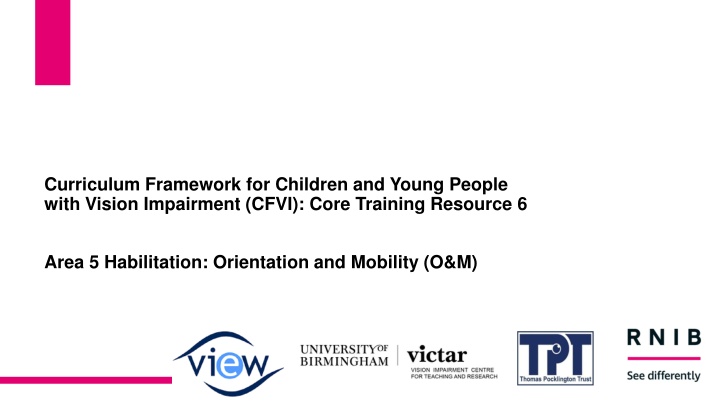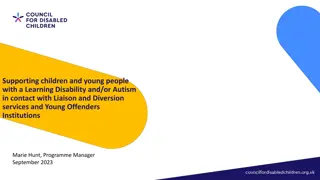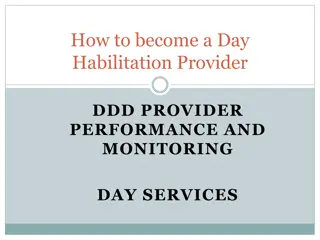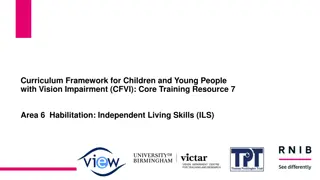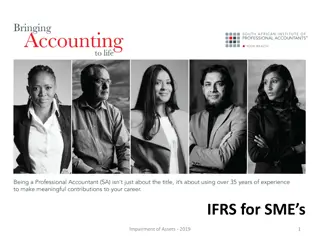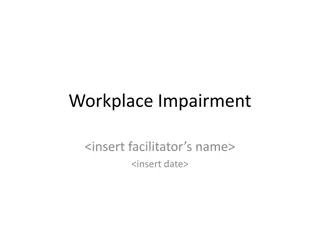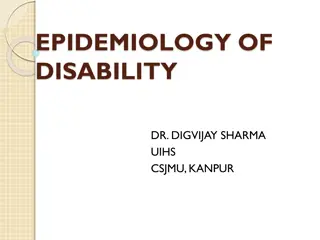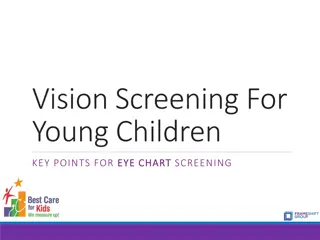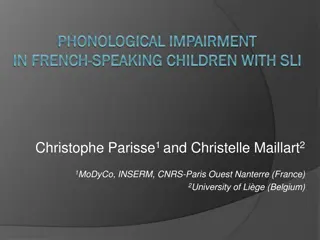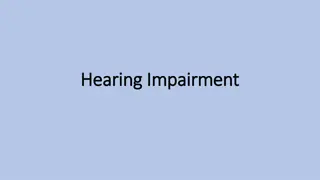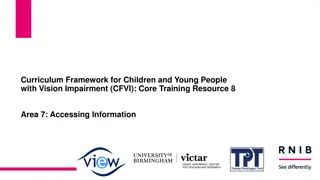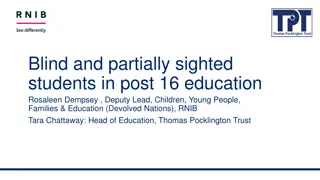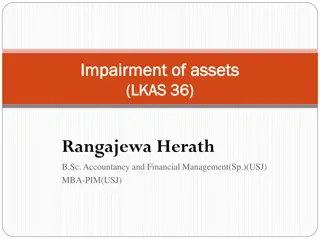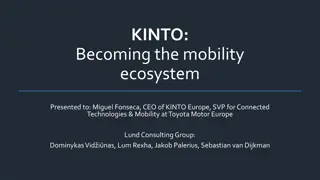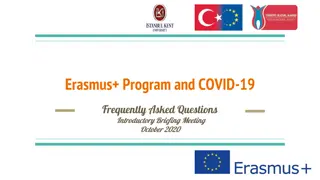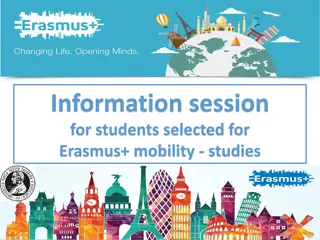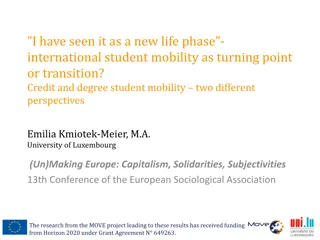Curriculum Framework for Children and Young People with Vision Impairment: Habilitation - Orientation and Mobility
The Curriculum Framework for Children and Young People with Vision Impairment focuses on Habilitation: Orientation and Mobility, providing training objectives, partner organizations, and information on teaching individuals with vision impairment to navigate their surroundings safely. The resource offers insights, examples, and useful resources to enhance the inclusion and development of learners with visual challenges.
Download Presentation

Please find below an Image/Link to download the presentation.
The content on the website is provided AS IS for your information and personal use only. It may not be sold, licensed, or shared on other websites without obtaining consent from the author.If you encounter any issues during the download, it is possible that the publisher has removed the file from their server.
You are allowed to download the files provided on this website for personal or commercial use, subject to the condition that they are used lawfully. All files are the property of their respective owners.
The content on the website is provided AS IS for your information and personal use only. It may not be sold, licensed, or shared on other websites without obtaining consent from the author.
E N D
Presentation Transcript
Curriculum Framework for Children and Young People with Vision Impairment (CFVI): Core Training Resource 6 Area 5 Habilitation: Orientation and Mobility (O&M)
Project Partners There are 4 partner organisations involved in the CFVI project. The production of these training/continuing professional development materials was led by VIEW (The Professional Association for the Vision Impairment Education Workforce), in association with a consultation group of stakeholders working in the field of VI Education.
Curriculum Framework for Children and Young People with Vision Impairment (2022, p.15)
Training Objectives (1) The objectives of this training resource are to provide: an introduction to Area 5 of the CFVI - Habilitation: Orientation and Mobility. examples of potential barriers to facilitating inclusion for learners with vision impairment and targeted intervention approaches we can draw upon to help reduce these. an opportunity to reflect on the social experiences and developmental paths of individual young people with vision impairment. some links to useful resources/websites.
Training Objectives (2) Customisable slide if needed (see notes for the previous slide which give examples of training objectives that you could consider, depending on the nature of your presentation).
About this area: Habilitation: Orientation and Mobility This area of the framework, closely aligned to Area 2: Sensory Development, recognises the importance of teaching children and young people with VI to be able to navigate the world around them and move safely from one area to the next. Much of the teaching and support will be undertaken by, or under the direction of a registered Qualified Registered Habilitation Specialist (QRHS) who will work in liaison with parents and professionals such as occupational therapists and specialist teachers. The work might be undertaken by a rehabilitation worker (vision impairment) when moving into adulthood.
Identifying potential barriers to access (1) Situation A pupil without a vision impairment moving between classrooms at school/college. What does vision tell the child in this situation? where the class peer group are going. how crowded corridors are/how cluttered the floor is. how busy the stairs are. how many stairs there are; where they start/end. room numbers on a corridor as an indicator of where you are. visual landmarks within a school/college building to aid orientation.
Identifying potential barriers to access (2) Situation A pupil with a vision impairment moving between classrooms at school/college. What does vision tell the child in this situation? ?
Identifying potential barriers to access (3) Situation A child/young person without a vision impairment travelling to school/college/work by bus. What does vision tell the child in this situation? A bus is coming. The bus number it s the correct bus. Ways of paying e.g. touch pad for bus pass where that is located. Where their peers are sitting. Where there is a free seat/room to stand. Where you are on the route: visual display of landmarks seen through the window. When to ring the bell for the next stop or move to exit. Exiting the bus safely (are there people/obstacles in the way; height to pavement etc).
Identifying potential barriers to access (4) Situation A child/young person without a vision impairment travelling to school/college/work by bus. What does vision tell the child in this situation? ?
Identifying potential barriers to access (5) Child/young person brief profile Add here Situation ?
Why a focus on this area is important (1) Why is the ability to navigate safely and confidently important for all children and young people?
Why a focus on this area is important (2) Why is a focus on this area important for children and young people with vision impairment? Movement aids learning through exploration and physical contact with the environment. They often need direct interventions to explore their surroundings which they may potentially find frightening, unpredictable or unmotivating. O&M intervention assists them in knowing where they are (orientation), where they want to go to and gives them the skills to get there (mobility). O&M skills should be developed in the early years (e.g. basic body awareness/movement) and are likely to continue into adulthood as the individual learns skills/needs new skills that allow efficient, safe and effective navigation of their world.
Why a focus on this area is important (3) There are the immediate goals e.g. safely navigating the school environment or travelling to school/college. There are longer term goals which link to CFVI Area 11: Preparing for Adulthood including: independence in travel and mobility. emotional well-being (links to Area 9 of CFVI); self advocacy and personal agency; being confident in problem solving. assessment of risk. using technology to support O & M. future economic well-being.
Examples of targeted intervention approaches for Area 5 listed in CFVI to reduce barriers (1) Body awareness. Motor skills development (fine and gross) the ability to move and interact with one s immediate and distant environment. Engaging actively with surroundings. Using senses to navigate environment. Development of spatial cognition including mental maps of the environment. Walking safely indoors. Navigating indoor environments. Working with sighted guide.
Examples of targeted intervention approaches for Area 5 listed in CFVI to reduce barriers (2) Walking safely outdoors. Using landmarks. Planning safe and efficient routes. Using tactile maps for orientation and mobility. Navigating outdoor environments, including road safety. Using mobility aides, including from an early age. This would include a full range of potential mobility aids, e.g. various canes, guide dog, electronic devices (including specialist Apps and equipment), smart wheelchair with switch. Using public transport.
Examples of targeted intervention approaches for Area 5 listed in CFVI to reduce barriers (3) Travelling alone, including interacting with the general public. Travelling to unfamiliar places. Accessing information in public places. Understanding own needs and knowing when to ask for help. Core functional skills for sports and fitness.
Why a focus on this area is important for (name of child/young person); what interventions are in place? Details of pupil s vision impairment. How it influences their access to their mobility and orientation, access to the curriculum, social interactions. What interventions are in place to promote their mobility and orientation skills? What are the envisaged outcomes? Who delivers/works on these outcomes?
Summing up Vision impairment creates distinctive barriers to access, learning and participation for children and young people. Targeted intervention approaches within inclusive learning environments and the wider world (See CFVI, Area 1) are required to promote the development of effective mobility and orientation skills. Collaborative working with the child/young person, family and educators is required to maximise the use and development of their mobility and orientation skills.
What resources are available The Bookshare Hub hosting resources to support the delivery of the CFVI is available from the RNIB (External) Of particular relevance to this area is the Habilitation (O&M) category of the CFVI Resource Hub The CFVI provides a list of targeted intervention approaches (page 24): Curriculum Framework for Children and Young People with Vision Impairment | RNIB Habilitation VI UK has lots of useful information Guide Dogs UK Charity For The Blind And Partially Sighted has lots of useful information about habilitation for children, young people and families
References Hewett, R., Douglas, G., McLinden, M., James, L., Brydon, G., Chattaway, T.,Cobb, R., Keil, S., Raisanen, S., Sutherland, C., Taylor, J., (2022) Curriculum Framework for Children and young People with Vision Impairment[CFVI]: Defining specialist skills development and best practice support to promote equity, inclusion and personal agency. RNIB Hayton, J., & Wood, A. (2022). Quality Standards: Delivery of Habilitation Training (Mobility and Independent Living Skills) for Children and Young People with Visual Impairment (2nd ed.). RNIB Willis, l., Mort, S., Turton, D., Priestley, L., Reed, K., Lambert, A., Adams, S. (2022). Habilitation Tracker 2.0: Keeping Track of Progress in Habilitation. Habilitation VI UK
